Low-Cost EEG Multi-Subject Recording Platform for the Assessment of Students’ Attention and the Estimation of Academic Performance in Secondary School
Abstract
:1. Introduction
1.1. Context and Current Approaches
- They include systematic biases related to order, scale and halo effects, psychological factors, and others;
- These measurements are uncorrelated (and even negatively correlated) with independent, objective measures related to the variable of interest;
- These are difficult to aggregate and interpret because they are often represented in ordinal scales.
1.2. Objectives and Expected Outcomes
- (1)
- To develop a low-cost EEG multi-subject recording platform for the real-time assessment of students’ attention;
- (2)
- To conduct an experiment with secondary students in a real classroom, with curricular content, as an assessable activity and record multiple subjects simultaneously, in order to validate the EEG platform as a reliable and useful tool to measure the attention and helping teachers anticipate the academic performance of their students.
- Developing a pioneer and specialized platform for this study, avoiding the use of the manufacturer’s processing application;
- Conducting experiments in a realistic environment;
- Carrying out the experimentation using assessable curriculum content;
- Conducting the experimentation with students in compulsory secondary education;
- Simultaneous recording of multiple subjects.
2. Materials and Methods
2.1. Participants
2.2. Recordings
2.3. Experimental Design
2.3.1. Platform Architecture
- Bluetooth server;
- Main server: signal processor;
- Main server: HTML web interface.
2.3.2. Experimental Procedure
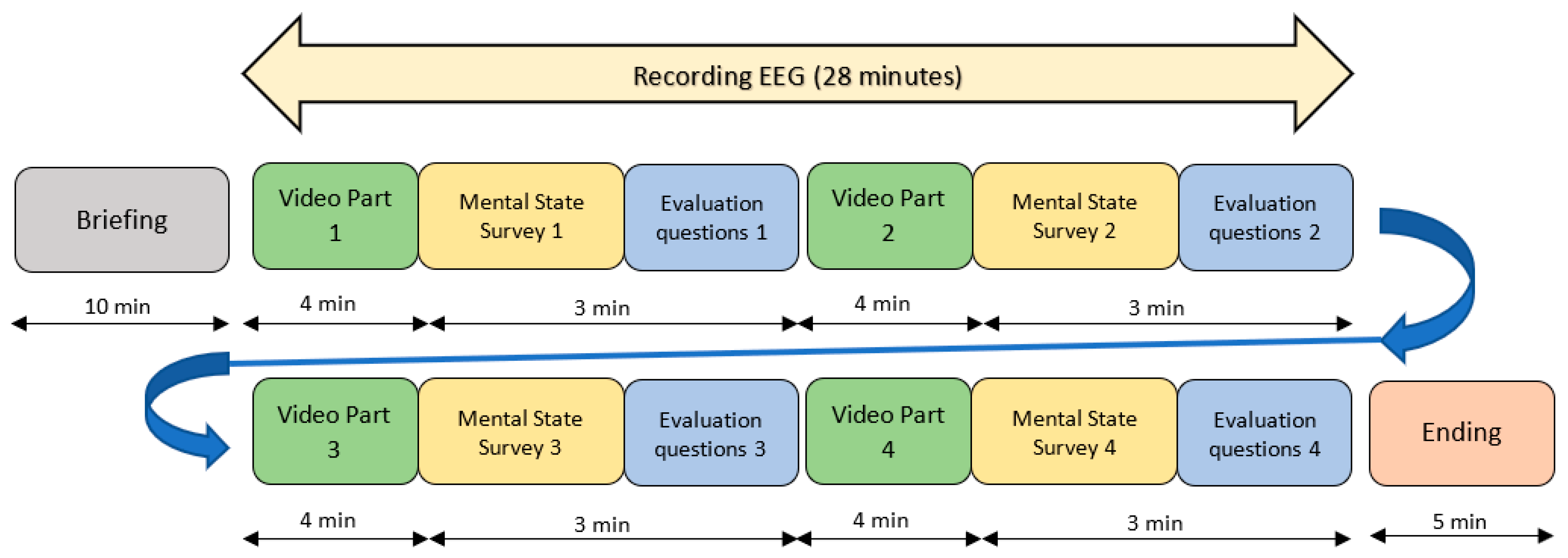
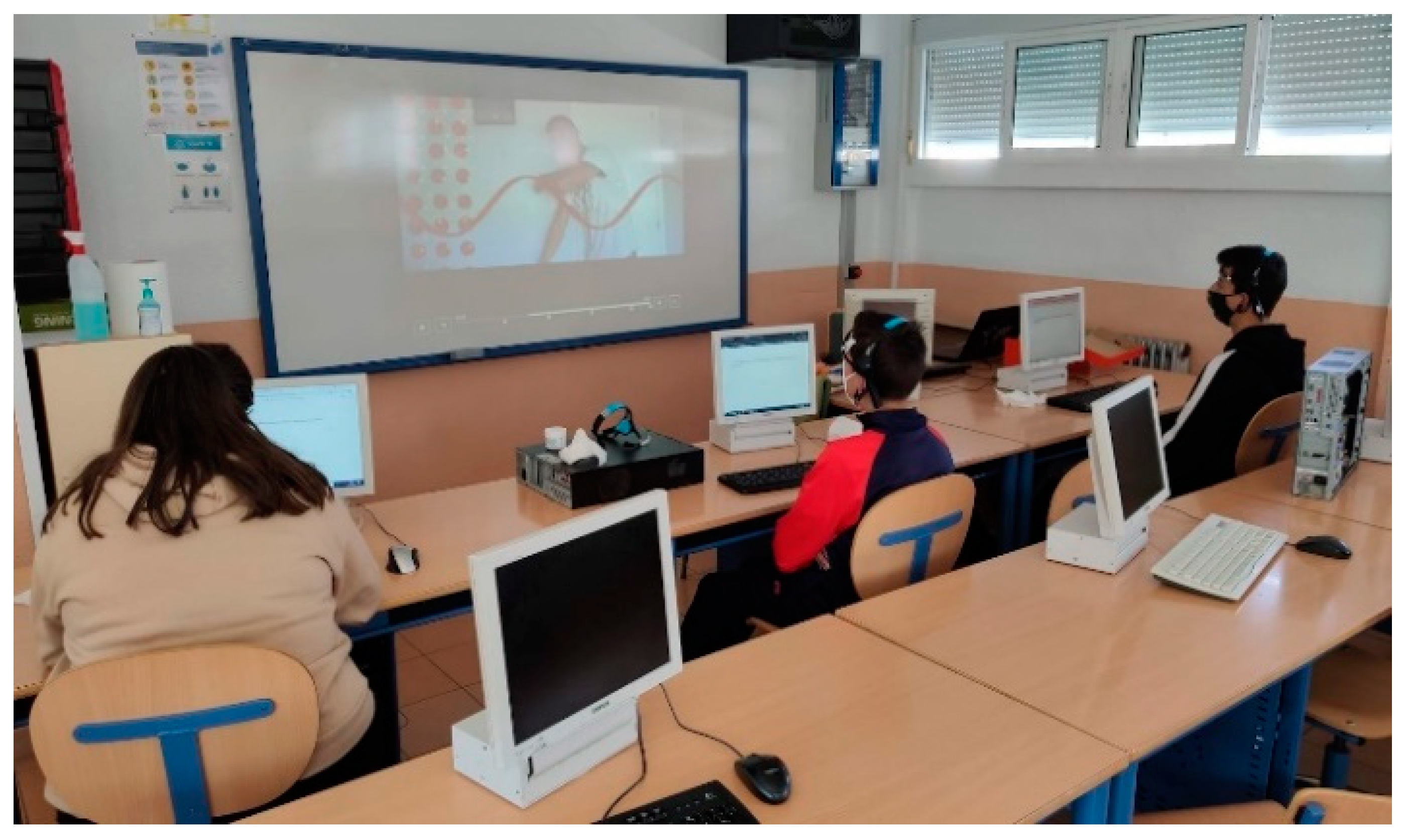
2.4. Signal Processing and Statistical Analysis
3. Results
3.1. Continuous Analysis
3.2. Group Analysis
3.3. Classification Model
4. Discussion
5. Conclusions
5.1. Limitations
- a.
- The number of participants that can be registered simultaneously due to the Bluetooth connection is limited to four;
- b.
- The use of a single dry electrode, while appropriate in terms of usability and cost, limits the richness and quality of the EEG signal. Another study using more sophisticated devices, with a greater number of wet electrodes, would be possible, but it would be outside the scope of this study’s purpose, mainly due to higher costs and more difficult preparation for the user;
- c.
- The number of participants. Although the sample size is low for solid conclusions, the results shown in this work support the relationship between the total mean PSD of beta and the academic performance;
- d.
- The main claim of our work is to introduce a new low-cost EEG platform capable of recording, processing, and delivering valuable real-time information to teachers in a real classroom setting. Our primary focus is not on developing an optimal EEG signal processing algorithm, but to show the benefits of the use of such a platform. The efficiency of our platform could possibly improve with a more advanced technique like artificial intelligence (AI).
5.2. Future Work
Author Contributions
Funding
Institutional Review Board Statement
Informed Consent Statement
Data Availability Statement
Acknowledgments
Conflicts of Interest
References
- Feng, X.; Ioan, N.; Li, Y. Comparison of the Effect of Online Teaching during COVID-19 and Pre-Pandemic Traditional Teaching in Compulsory Education. J. Educ. Res. 2021, 114, 307–316. [Google Scholar] [CrossRef]
- Kulikowski, K.; Przytuła, S.; Sułkowski, Ł. E-learning? Never Again! On the Unintended Consequences of COVID-19 Forced E-learning on Academic Teacher Motivational Job Characteristics. High. Educ. Q. 2022, 76, 174–189. [Google Scholar] [CrossRef]
- Darvishi, A.; Khosravi, H.; Sadiq, S.; Weber, B. Neurophysiological Measurements in Higher Education: A Systematic Literature Review. Int. J. Artif. Intell. Educ. 2021, 32, 413–445. [Google Scholar] [CrossRef]
- Greene, B.A. Measuring Cognitive Engagement with Self-Report Scales: Reflections From Over 20 Years of Research. Educ. Psychol. 2015, 50, 14–30. [Google Scholar] [CrossRef]
- Shah, S.M.H.; Saleem, S. Level of Attention of Secondary School Students and Its Relationship with Their Academic Achievement. J. Arts Humanit. 2015, 4, 92–106. [Google Scholar]
- Jahedi, S.; Méndez, F. On the Advantages and Disadvantages of Subjective Measures. J. Econ. Behav. Organ. 2014, 98, 97–114. [Google Scholar] [CrossRef]
- Bulut Özek, M. The Effects of Merging Student Emotion Recognition with Learning Management Systems on Learners’ Motivation and Academic Achievements. Comput. Appl. Eng. Educ. 2018, 26, 1862–1872. [Google Scholar] [CrossRef]
- Durall, E.; Leinonen, T. Feeler: Supporting Awareness and Reflection about Learning through EEG Data. In Proceedings of the 5th Workshop on Awareness and Reflection in Technology Enhanced Learning; Kravcik, A.M.M., Pammer, M.P.V., Eds.; CEUR: Aachen, Germany, 2015; pp. 67–73. [Google Scholar]
- Perez-Valero, E.; Morillas, C.; Lopez-Gordo, M.A.; Carrera-Muñoz, I.; López-Alcalde, S.; Vílchez-Carrillo, R.M. An Automated Approach for the Detection of Alzheimer’s Disease from Resting State Electroencephalography. Front. Neuroinform. 2022, 16, 924547. [Google Scholar] [CrossRef]
- Freismuth, D.; TaheriNejad, N. On the Treatment and Diagnosis of Attention Deficit Hyperactivity Disorder with EEG Assistance. Electronics 2022, 11, 606. [Google Scholar] [CrossRef]
- Alves, C.L.; Pineda, A.M.; Roster, K.; Thielemann, C.; Rodrigues, F.A. EEG Functional Connectivity and Deep Learning for Automatic Diagnosis of Brain Disorders: Alzheimer’s Disease and Schizophrenia. J. Phys. Complex. 2022, 3, 025001. [Google Scholar] [CrossRef]
- Minguillon, J.; Perez, E.; Lopez-Gordo, M.; Pelayo, F.; Sanchez-Carrion, M. Portable System for Real-Time Detection of Stress Level. Sensors 2018, 18, 2504. [Google Scholar] [CrossRef]
- Liu, N.-H.; Chiang, C.-Y.; Chu, H.-C. Recognizing the Degree of Human Attention Using EEG Signals from Mobile Sensors. Sensors 2013, 13, 10273–10286. [Google Scholar] [CrossRef] [PubMed]
- You, S.D. Classification of Relaxation and Concentration Mental States with EEG. Information 2021, 12, 187. [Google Scholar] [CrossRef]
- Ron-Angevin, R.; Lopez, M.A.; Pelayo, F. The Training Issue in Brain-Computer Interface: A Multi-Disciplinary Field. In Bio-Inspired Systems: Computational and Ambient Intelligence; Cabestany, J., Sandoval, F., Prieto, A., Corchado, J.M., Eds.; Lecture Notes in Computer Science; Springer: Berlin/Heidelberg, Germany, 2009; Volume 5517, pp. 666–673. ISBN 978-3-642-02477-1. [Google Scholar]
- Li, Y.; Zheng, T.; Wang, M.; Dong, L.; Wang, P.; Qin, X. A Coloring and Timing Brain-Computer Interface for the Nursing Bed Robot. Comput. Electr. Eng. 2021, 95, 107415. [Google Scholar] [CrossRef]
- Sharma, H.; Mahajan, R.; Sakthivel, G.; Saravanakumar, D.; Raghukiran, N. Brain Computer Interface Controlled Wheel Chair. J. Phys. Conf. Ser. 2021, 1969, 012065. [Google Scholar] [CrossRef]
- Lopez-Gordo, M.A.; Pelayo, F.; Fernandez, E.; Padilla, P. Phase-Shift Keying of EEG Signals: Application to Detect Attention in Multitalker Scenarios. Signal Process. 2015, 117, 165–173. [Google Scholar] [CrossRef]
- Perez-Valero, E.; Lopez-Gordo, M.A.; Vaquero-Blasco, M.A. An Attention-driven Videogame Based on Steady-State Motion Visual Evoked Potentials. Expert Syst. 2021, 38, e12682. [Google Scholar] [CrossRef]
- Amin, M.; Tubaishat, A.; Al-Obeidat, F.; Shah, B.; Karamat, M. Leveraging Brain–Computer Interface for Implementation of a Bio-Sensor Controlled Game for Attention Deficit People. Comput. Electr. Eng. 2022, 102, 108277. [Google Scholar] [CrossRef]
- Rieiro, H.; Diaz-Piedra, C.; Morales, J.M.; Catena, A.; Romero, S.; Roca-Gonzalez, J.; Fuentes, L.J.; Di Stasi, L.L. Validation of Electroencephalographic Recordings Obtained with a Consumer-Grade, Single Dry Electrode, Low-Cost Device: A Comparative Study. Sensors 2019, 19, 2808. [Google Scholar] [CrossRef] [PubMed]
- Mallikarjun, H.M.; Manimegalai, P.; Suresh, H.N. Machine Learning Based Classifier for Falsehood Detection. IOP Conf. Ser. Mater. Sci. Eng. 2017, 225, 012258. [Google Scholar] [CrossRef]
- Morales, J.M.; Díaz-Piedra, C.; Rieiro, H.; Roca-González, J.; Romero, S.; Catena, A.; Fuentes, L.J.; Di Stasi, L.L. Monitoring Driver Fatigue Using a Single-Channel Electroencephalographic Device: A Validation Study by Gaze-Based, Driving Performance, and Subjective Data. Accid. Anal. Prev. 2017, 109, 62–69. [Google Scholar] [CrossRef]
- KB, S.K.; Krishna, G.; Bhalaji, N.; Chithra, S. BCI Cinematics—A Pre-Release Analyser for Movies Using H2O Deep Learning Platform. Comput. Electr. Eng. 2019, 74, 547–556. [Google Scholar] [CrossRef]
- Wang, J.-W.; Zhang, D.-W.; Johnstone, S.J. Portable EEG for Assessing Attention in Educational Settings: A Scoping Review. arXiv 2023. [Google Scholar] [CrossRef]
- Dikker, S.; Haegens, S.; Bevilacqua, D.; Davidesco, I.; Wan, L.; Kaggen, L.; McClintock, J.; Chaloner, K.; Ding, M.; West, T.; et al. Morning Brain: Real-World Neural Evidence That High School Class Times Matter. Soc. Cogn. Affect. Neurosci. 2020, 15, 1193–1202. [Google Scholar] [CrossRef]
- Babiloni, F.; Astolfi, L. Social Neuroscience and Hyperscanning Techniques: Past, Present and Future. Neurosci. Biobehav. Rev. 2014, 44, 76–93. [Google Scholar] [CrossRef] [PubMed]
- Sezer, A.; İnel, Y.; Seçkin, A.Ç.; Uluçınar, U. An Investigation of University Students’ Attention Levels in Real Classroom Settings with NeuroSky’s MindWave Mobile (EEG) Device. In Proceedings of the International Educational Technology Conference–IETC 2015, Istanbul, Turkey, 27–29 May 2015; Volume 2015. [Google Scholar]
- Lancheros-Cuesta, D.J.; Carrillo-Ramos, A.; Lancheros-Cuesta, M. Evaluation of Content Adaptation: Case Study with NeuroSky MindWave in Children with Learning Difficulties. Int. J. Web Inf. Syst. 2019, 15, 474–488. [Google Scholar] [CrossRef]
- Rebolledo-Mendez, G.; Dunwell, I.; Martínez-Mirón, E.A.; Vargas-Cerdán, M.D.; de Freitas, S.; Liarokapis, F.; García-Gaona, A.R. Assessing NeuroSky’s Usability to Detect Attention Levels in an Assessment Exercise. In Human-Computer Interaction. New Trends; Jacko, J.A., Ed.; Lecture Notes in Computer Science; Springer: Berlin/Heidelberg, Germany, 2009; Volume 5610, pp. 149–158. ISBN 978-3-642-02573-0. [Google Scholar]
- Salabun, W. Processing and Spectral Analysis of the Raw EEG Signal from the MindWave. Prz. Elektrotechniczny 2014, 90, 169–173. [Google Scholar] [CrossRef]
- Kang, J.-S.; Ojha, A.; Lee, M. Concentration Monitoring with High Accuracy but Low Cost EEG Device. In Neural Information Processing; Arik, S., Huang, T., Lai, W.K., Liu, Q., Eds.; Lecture Notes in Computer Science; Springer International Publishing: Cham, Switzerland, 2015; Volume 9492, pp. 54–60. ISBN 978-3-319-26560-5. [Google Scholar]
- Wolska, A.; Sawicki, D.; Kołodziej, M.; Wisełka, M.; Nowak, K. Which EEG Electrodes Should Be Considered for Alertness Assessment? In Proceedings of the 3rd International Conference on Computer-Human Interaction Research and Applications, Vienna, Austria, 20–21 September 2019; SCITEPRESS—Science and Technology Publications: Vienna, Austria, 2019; pp. 40–49. [Google Scholar]
- Ulker, B.; Tabakcioglu, M.B.; Cizmeci, H.; Ayberkin, D. Relations of Attention and Meditation Level with Learning in Engineering Education. In Proceedings of the 2017 9th International Conference on Electronics, Computers and Artificial Intelligence (ECAI), Targoviste, Romania, 29 June–1 July 2017; IEEE: Targoviste, Romania, 2017; pp. 1–4. [Google Scholar]
- Sethi, C.; Dabas, H.; Dua, C.; Dalawat, M.; Sethia, D. EEG-Based Attention Feedback to Improve Focus in E-Learning. In Proceedings of the 2018 2nd International Conference on Computer Science and Artificial Intelligence, Shenzhen, China, 8–10 December 2018; ACM: New York, NY, USA, 2018; pp. 321–326. [Google Scholar]
- NeuroSky Suppor Site How to Convert Raw Values to Voltage? Available online: http://support.neurosky.com/kb/science/how-to-convert-raw-values-to-voltage (accessed on 21 June 2021).
- Kane, N.; Acharya, J.; Beniczky, S.; Caboclo, L.; Finnigan, S.; Kaplan, P.W.; Shibasaki, H.; Pressler, R.; van Putten, M.J.A.M. A Revised Glossary of Terms Most Commonly Used by Clinical Electroencephalographers and Updated Proposal for the Report Format of the EEG Findings. Revision 2017. Clin. Neurophysiol. Pract. 2017, 2, 170–185. [Google Scholar] [CrossRef]
- Mennes, M.; Wouters, H.; Vanrumste, B.; Lagae, L.; Stiers, P. Validation of ICA as a Tool to Remove Eye Movement Artifacts from EEG/ERP. Psychophysiology 2010, 47, 1142–1150. [Google Scholar] [CrossRef]
- Dan, A.; Reiner, M. Reduced Mental Load in Learning a Motor Visual Task with Virtual 3D Method. J. Comput. Assist. Learn. 2018, 34, 84–93. [Google Scholar] [CrossRef]
- Edwards, A.A.; Massicci, A.; Sridharan, S.; Geigel, J.; Wang, L.; Bailey, R.; Alm, C.O. Sensor-Based Methodological Observations for Studying Online Learning. In Proceedings of the 2017 ACM Workshop on Intelligent Interfaces for Ubiquitous and Smart Learning, Limassol, Cyprus, 13 March 2017; ACM: New York, NY, USA, 2017; pp. 25–30. [Google Scholar]
- Gudmundsson, S.; Runarsson, T.P.; Sigurdsson, S.; Eiriksdottir, G.; Johnsen, K. Reliability of Quantitative EEG Features. Clin. Neurophysiol. 2007, 118, 2162–2171. [Google Scholar] [CrossRef] [PubMed]
- Pernet, C.R.; Wilcox, R.; Rousselet, G.A. Robust Correlation Analyses: False Positive and Power Validation Using a New Open Source Matlab Toolbox. Front. Psychol. 2013, 3, 606. [Google Scholar] [CrossRef] [PubMed]
- Rousselet, G.A.; Pernet, C.R. Improving Standards in Brain-Behavior Correlation Analyses. Front. Hum. Neurosci. 2012, 6, 119. [Google Scholar] [CrossRef] [PubMed]
- Taud, H.; Mas, J.F. Multilayer Perceptron (MLP). In Geomatic Approaches for Modeling Land Change Scenarios; Camacho Olmedo, M.T., Paegelow, M., Mas, J.-F., Escobar, F., Eds.; Lecture Notes in Geoinformation and Cartography; Springer International Publishing: Cham, Switzerland, 2018; pp. 451–455. ISBN 978-3-319-60800-6. [Google Scholar]
- Xu, J.; Zhong, B. Review on Portable EEG Technology in Educational Research. Comput. Hum. Behav. 2018, 81, 340–349. [Google Scholar] [CrossRef]
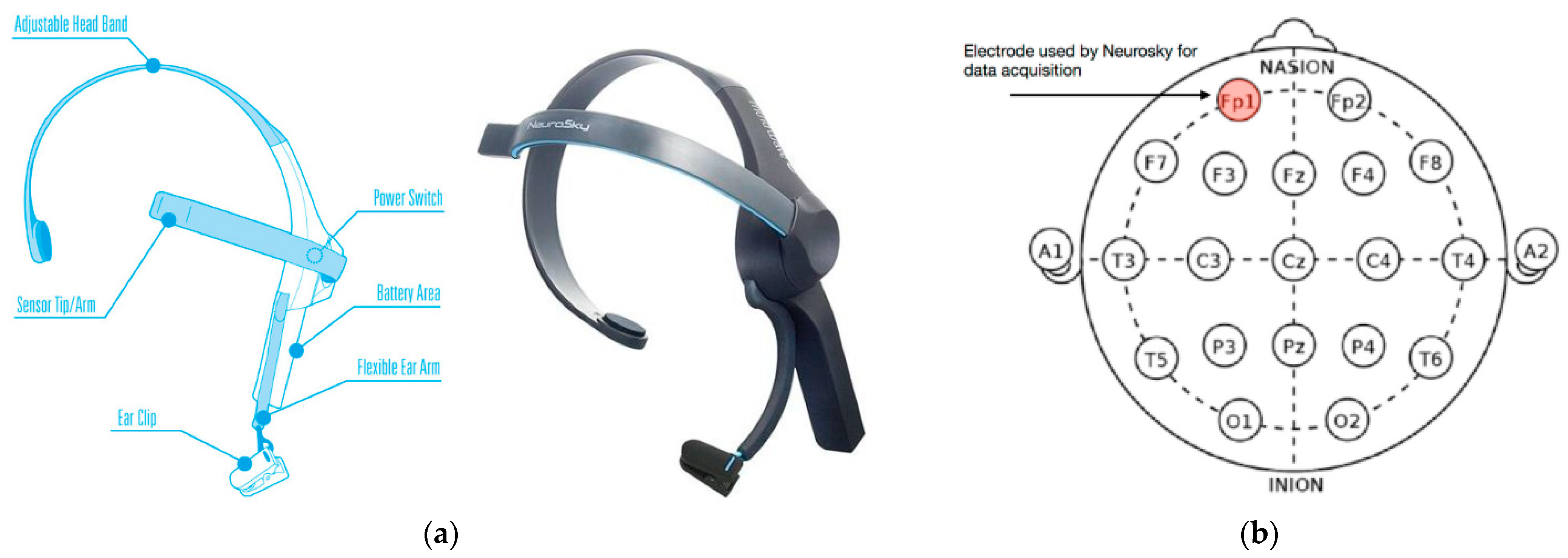

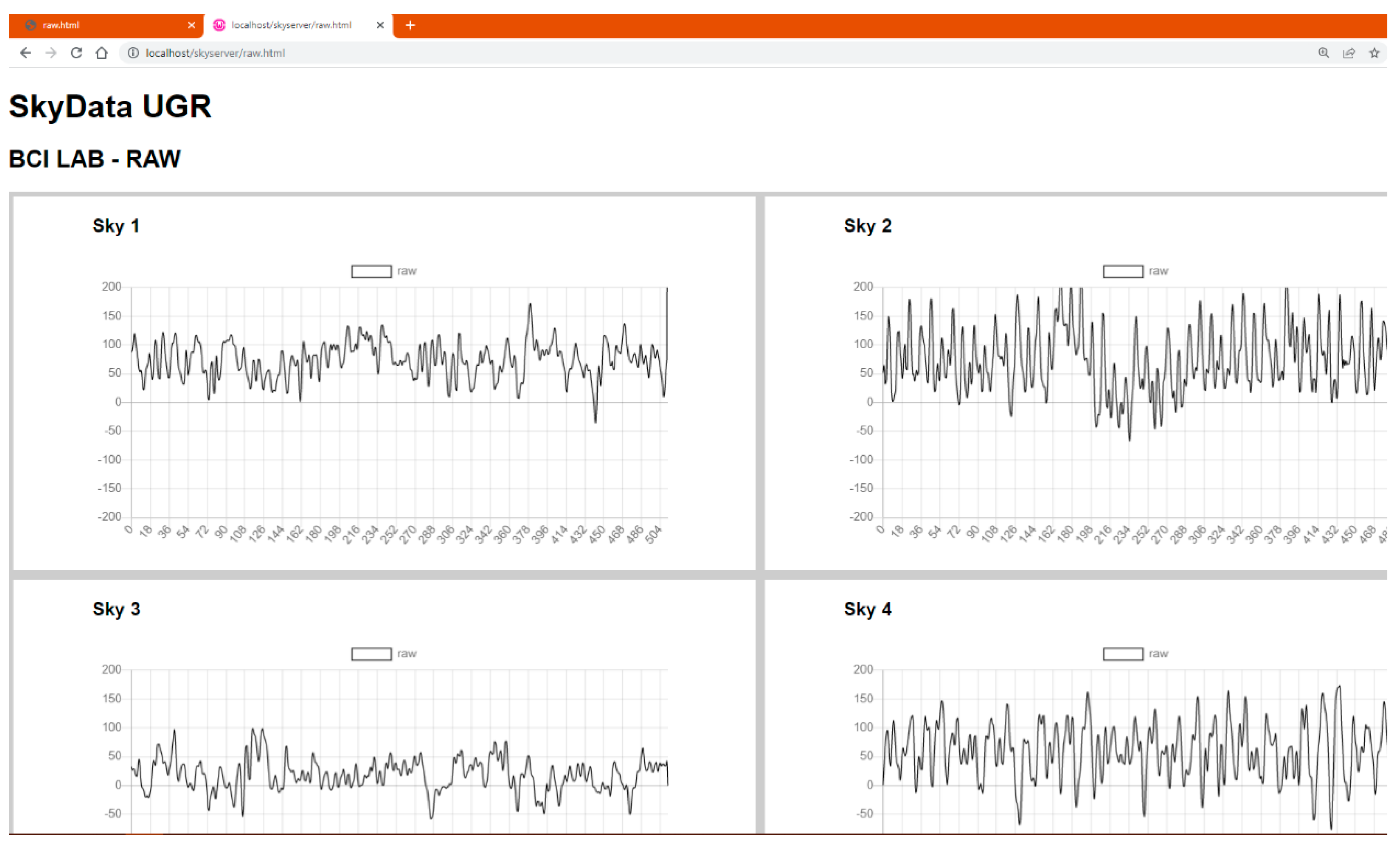

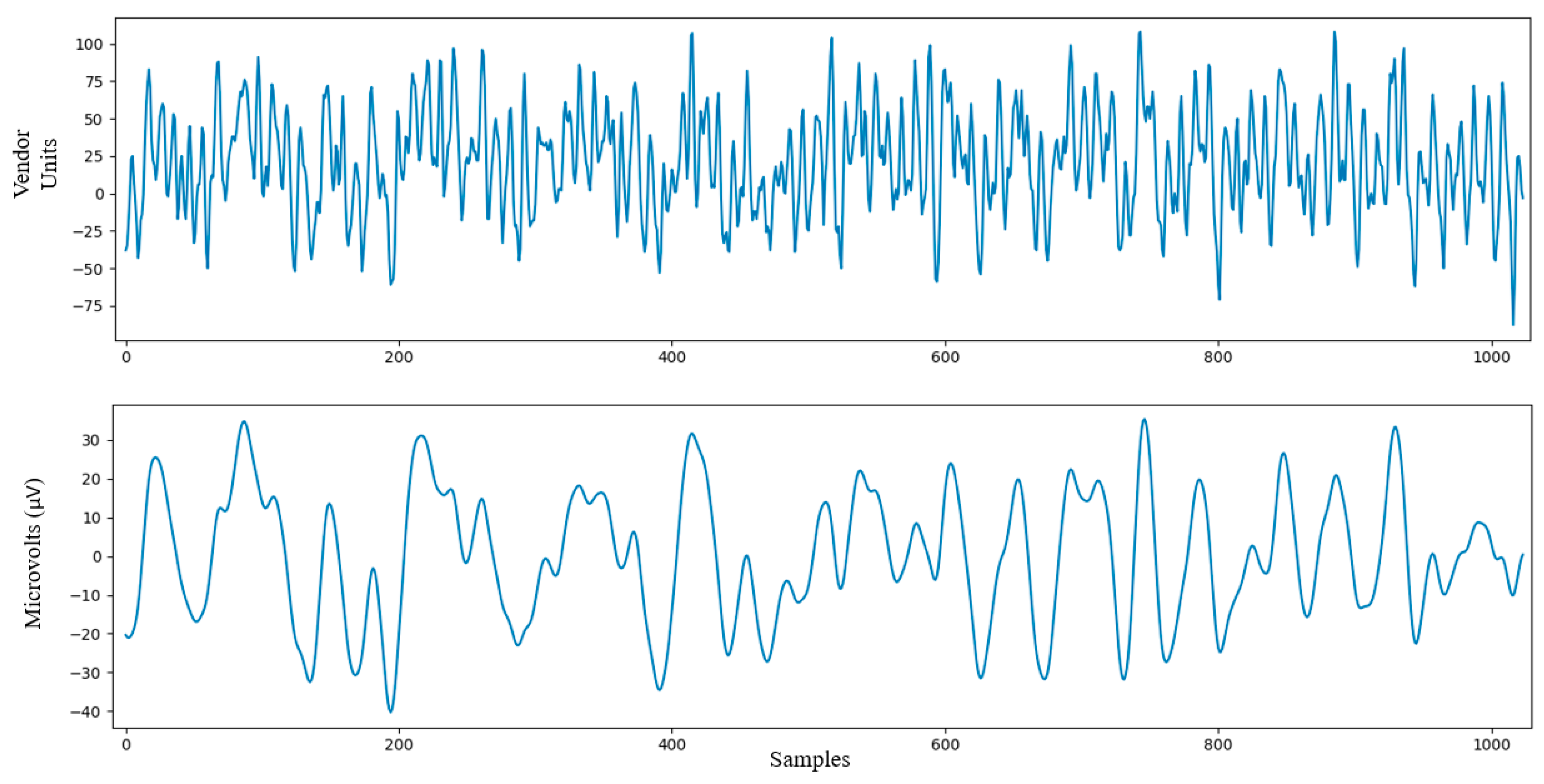
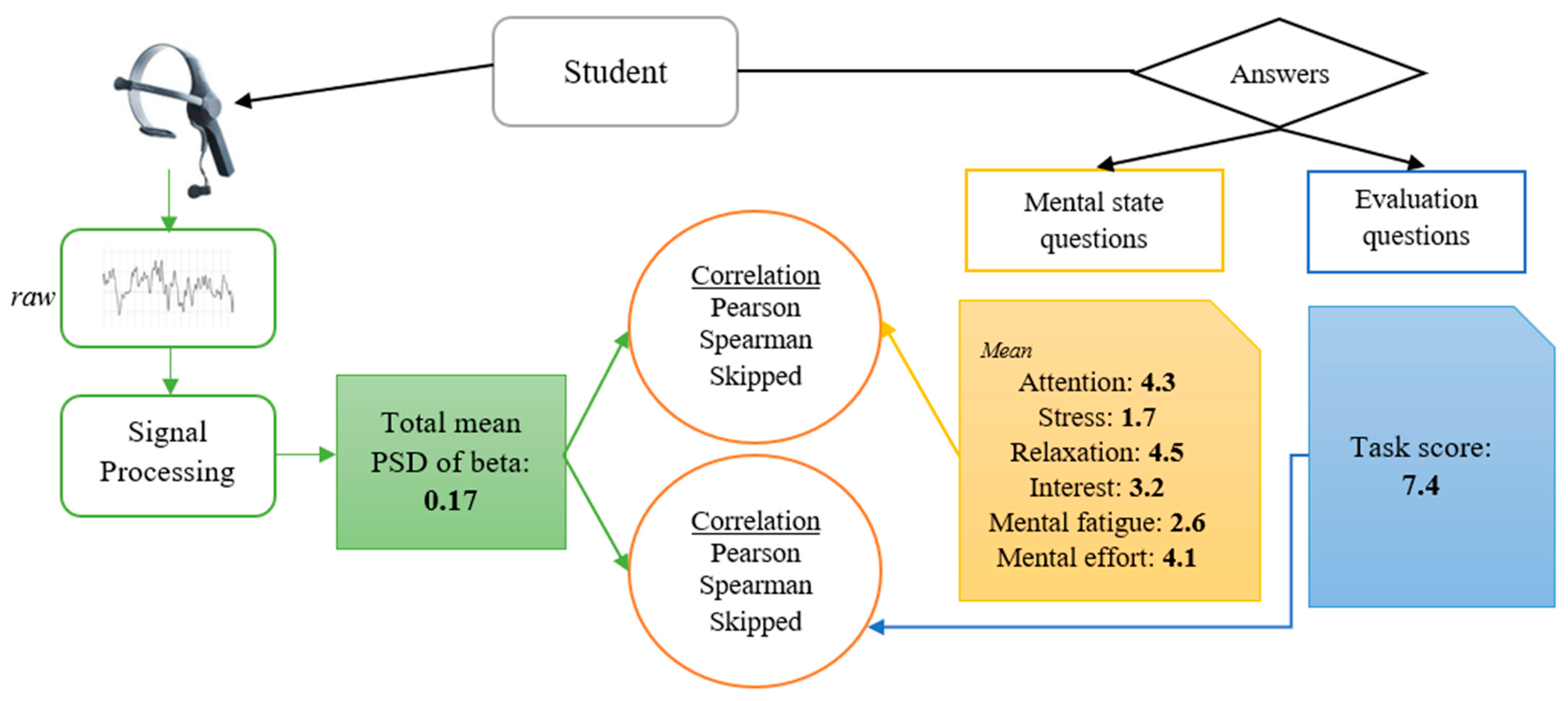
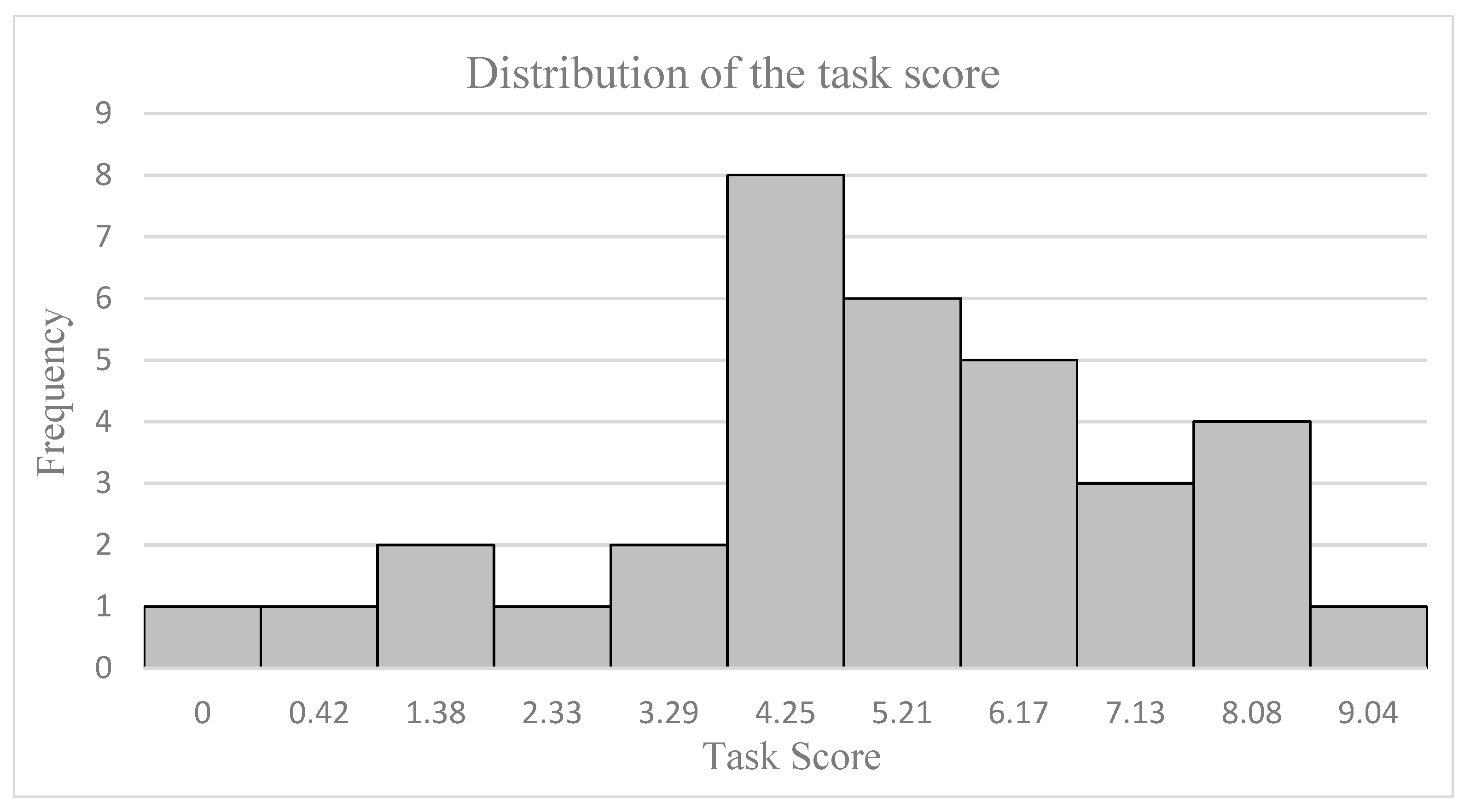
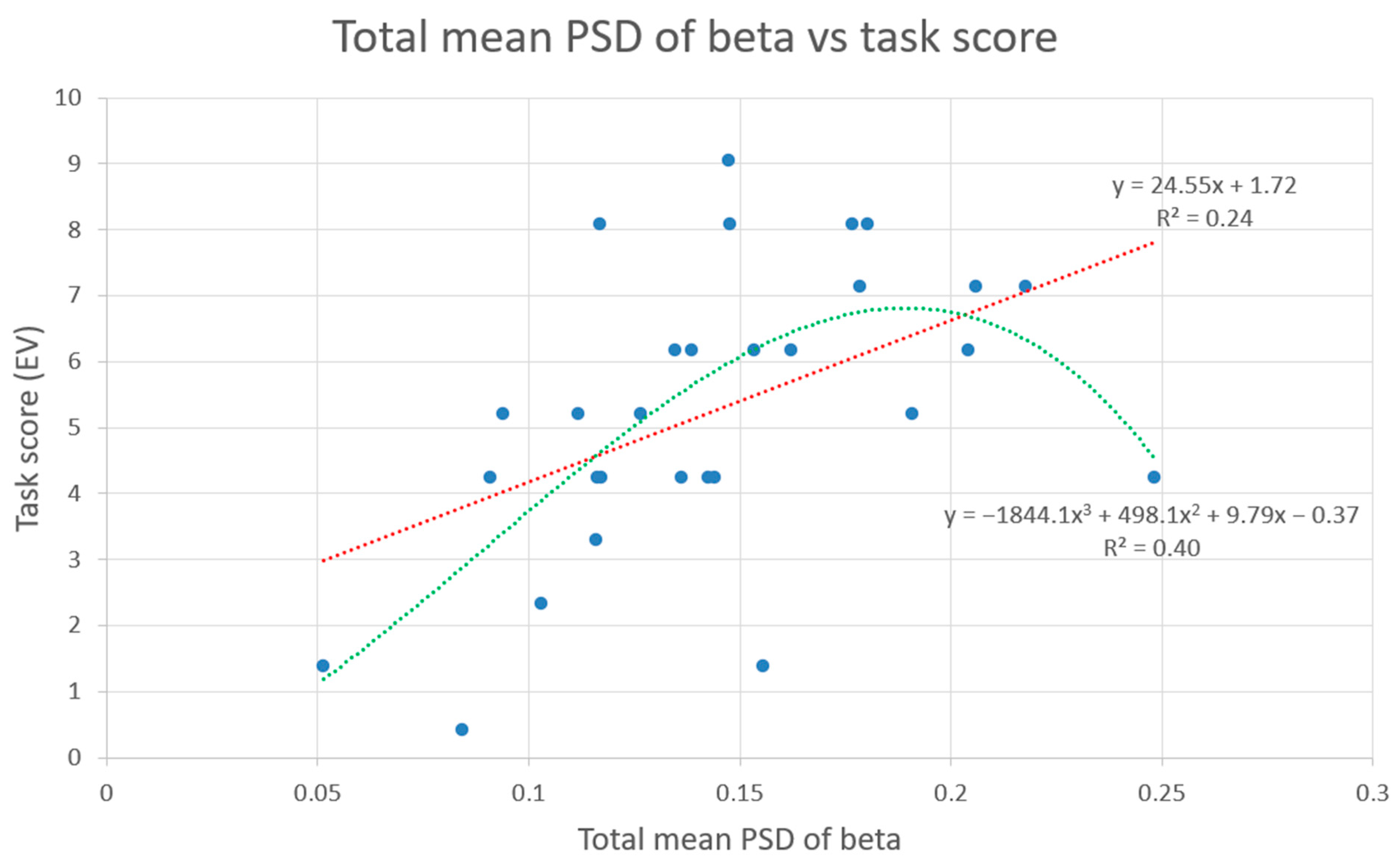
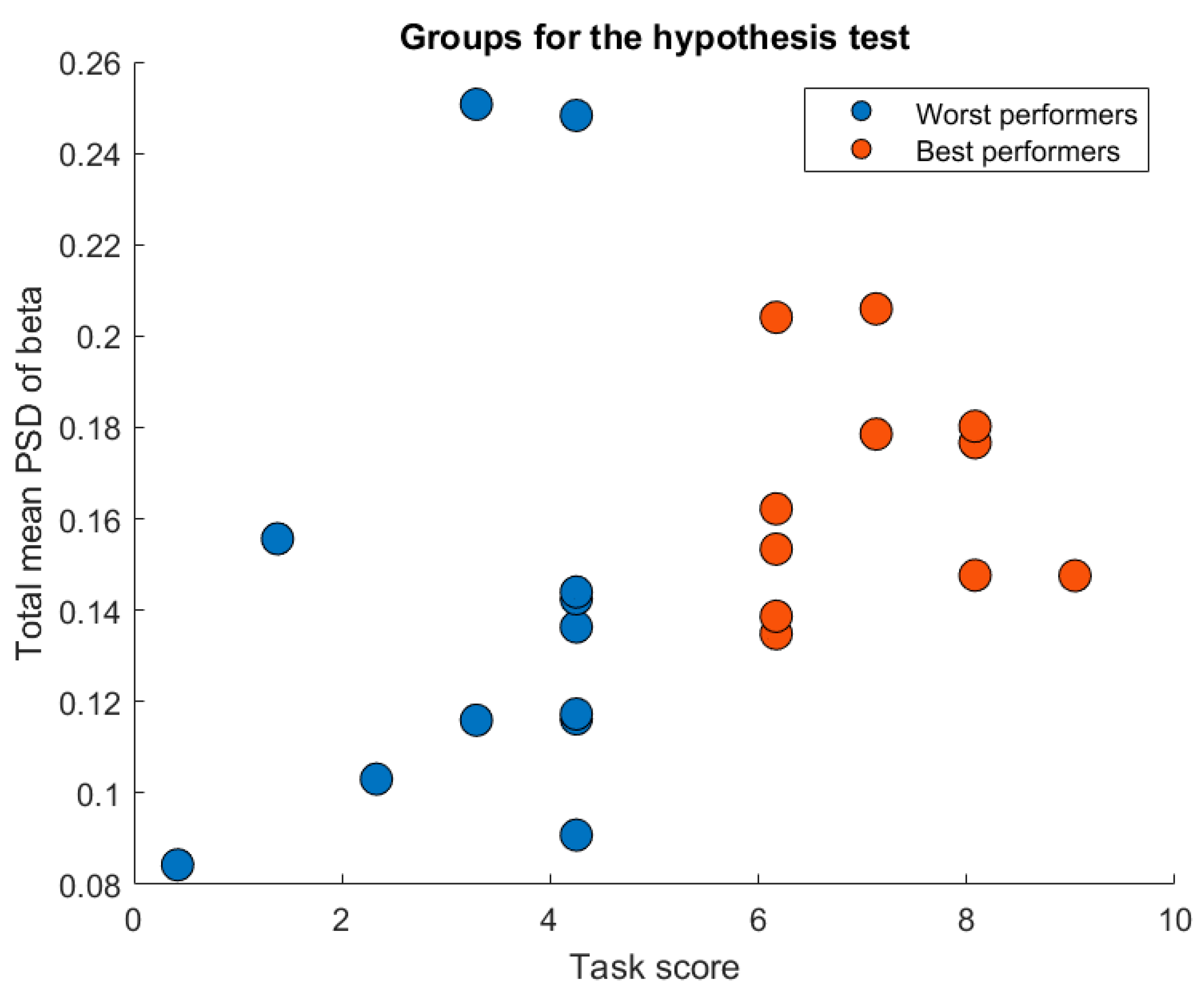
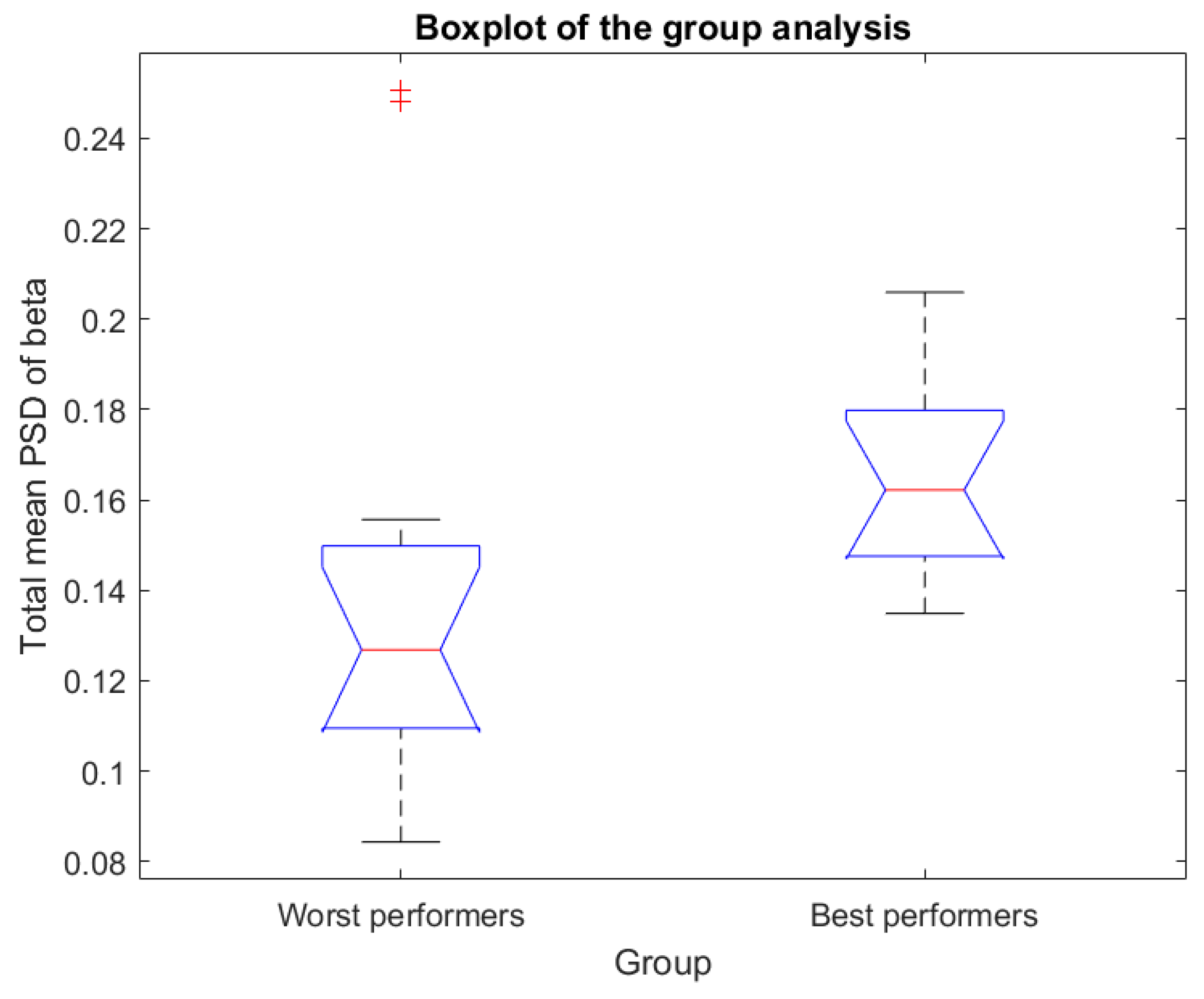
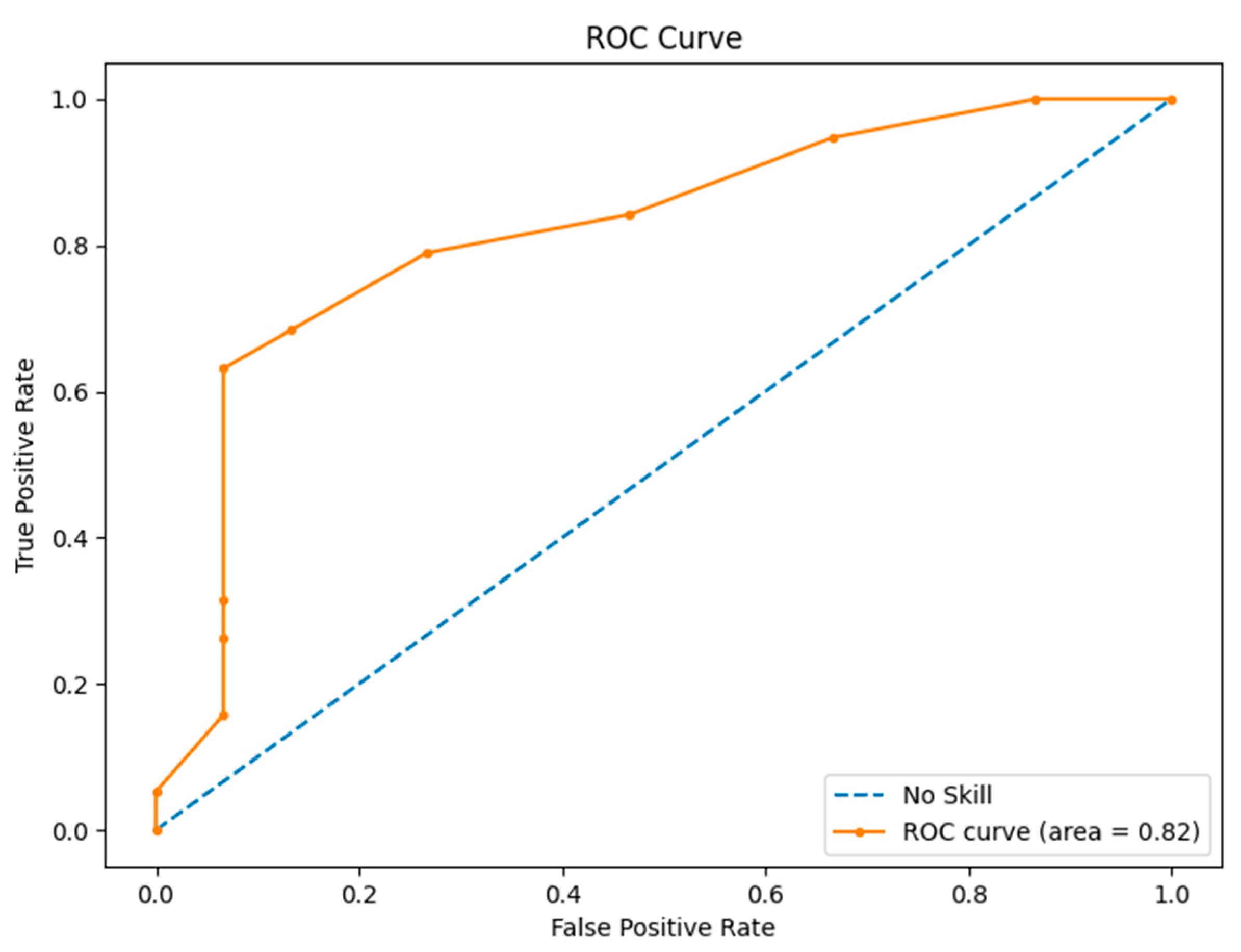
| Number | Question |
|---|---|
| 1 | What was your level of attention? |
| 2 | What was your level of stress? |
| 3 | What was your level of relaxation? |
| 4 | What was your level of interest? |
| 5 | What was your level of mental fatigue? |
| 6 | What was your level of mental effort? |
| Specification | Value |
|---|---|
| Sampling frequency per second | 512 |
| Window size (epoch) | 2 s (1024 samples) |
| Artifact filtering threshold | 75 µV |
| Signal discretization method | Fast Fourier transform |
| Signal amplitude range | −100, 100 µV |
| Target frequency band | Beta (12–30 Hz) |
| Noise filtering | Butterworth, detrend, z-scored, and Tukey window |
| Model | Outliers | R | CI95% | p-Value | Power | |
|---|---|---|---|---|---|---|
| Task score 1 | Pearson | 0 | 0.23 | [−0.12, 0.54] | 0.18 | 0.26 |
| Spearman | 0 | 0.32 | [−0.02, 0.6] | 0.06 | 0.46 | |
| Skipped | 5 | 0.53 | [0.21, 0.75] | 0.003 | 0.87 | |
| Interest 2 | Pearson | 0 | −0.04 | [−0.38, 0.31] | 0.81 | 0.05 |
| Spearman | 0 | −0.03 | [−0.37, 0.32] | 0.86 | 0.05 | |
| Skipped | 0 | −0.03 | [−0.37, 0.32] | 0.86 | 0.05 | |
| Attention 2 | Pearson | 0 | −0.05 | [−0.39, 0.29] | 0.76 | 0.06 |
| Spearman | 0 | −0.06 | [−0.39, 0.29] | 0.74 | 0.06 | |
| Skipped | 1 | 0.0 | [−0.35, 0.35] | 0.99 | 0.05 | |
| Mental fatigue 2 | Pearson | 0 | 0.04 | [−0.30, 0.38] | 0.80 | 0.05 |
| Spearman | 0 | 0.01 | [−0.33, 0.35] | 0.94 | 0.05 | |
| Skipped | 0 | 0.01 | [−0.33, 0.35] | 0.95 | 0.05 | |
| Mental effort 2 | Pearson | 0 | 0.04 | [−0.30, 0.38] | 0.80 | 0.05 |
| Spearman | 0 | 0.06 | [−0.4, 0.29] | 0.73 | 0.06 | |
| Skipped | 0 | 0.06 | [−0.4, 0.29] | 0.73 | 0.06 | |
| Stress 2 | Pearson | 0 | −0.21 | [−0.51, 0.15] | 0.24 | 0.21 |
| Spearman | 0 | −0.22 | [−0.53, 0.13] | 0.21 | 0.24 | |
| Skipped | 0 | −0.22 | [−0.53, 0.13] | 0.21 | 0.24 | |
| Relaxation 2 | Pearson | 0 | 0.09 | [−0.26, 0.43] | 0.59 | 0.08 |
| Spearman | 0 | −0.02 | [−0.37, 0.32] | 0.89 | 0.05 | |
| Skipped | 0 | −0.22 | [−0.37, 0.32] | 0.89 | 0.05 |
| Data | Mean | Standard Dev. | Median |
|---|---|---|---|
| Task score | 5.0 | 2.3 | 5.2 |
| Interest | 4.3 | 0.5 | 4.2 |
| Attention | 4.3 | 0.5 | 4.4 |
| Mental fatigue | 2.2 | 0.7 | 2.0 |
| Mental effort | 2.7 | 0.9 | 2.6 |
| Stress | 1.7 | 0.6 | 1.5 |
| Relaxation | 3.3 | 0.8 | 3.2 |
| True Positives | False Positives | False Negatives | True Negatives | Recall | Accuracy | Precision | F1-Score |
|---|---|---|---|---|---|---|---|
| 14 | 2 | 5 | 13 | 0.73 | 0.79 | 0.86 | 0.80 |
Disclaimer/Publisher’s Note: The statements, opinions and data contained in all publications are solely those of the individual author(s) and contributor(s) and not of MDPI and/or the editor(s). MDPI and/or the editor(s) disclaim responsibility for any injury to people or property resulting from any ideas, methods, instructions or products referred to in the content. |
© 2023 by the authors. Licensee MDPI, Basel, Switzerland. This article is an open access article distributed under the terms and conditions of the Creative Commons Attribution (CC BY) license (https://creativecommons.org/licenses/by/4.0/).
Share and Cite
Fuentes-Martinez, V.J.; Romero, S.; Lopez-Gordo, M.A.; Minguillon, J.; Rodríguez-Álvarez, M. Low-Cost EEG Multi-Subject Recording Platform for the Assessment of Students’ Attention and the Estimation of Academic Performance in Secondary School. Sensors 2023, 23, 9361. https://doi.org/10.3390/s23239361
Fuentes-Martinez VJ, Romero S, Lopez-Gordo MA, Minguillon J, Rodríguez-Álvarez M. Low-Cost EEG Multi-Subject Recording Platform for the Assessment of Students’ Attention and the Estimation of Academic Performance in Secondary School. Sensors. 2023; 23(23):9361. https://doi.org/10.3390/s23239361
Chicago/Turabian StyleFuentes-Martinez, Victor Juan, Samuel Romero, Miguel Angel Lopez-Gordo, Jesus Minguillon, and Manuel Rodríguez-Álvarez. 2023. "Low-Cost EEG Multi-Subject Recording Platform for the Assessment of Students’ Attention and the Estimation of Academic Performance in Secondary School" Sensors 23, no. 23: 9361. https://doi.org/10.3390/s23239361
APA StyleFuentes-Martinez, V. J., Romero, S., Lopez-Gordo, M. A., Minguillon, J., & Rodríguez-Álvarez, M. (2023). Low-Cost EEG Multi-Subject Recording Platform for the Assessment of Students’ Attention and the Estimation of Academic Performance in Secondary School. Sensors, 23(23), 9361. https://doi.org/10.3390/s23239361








